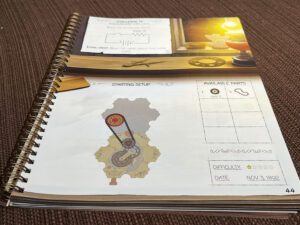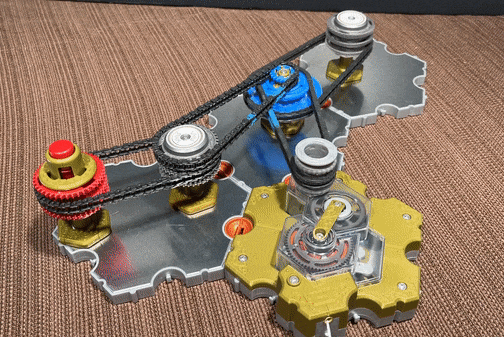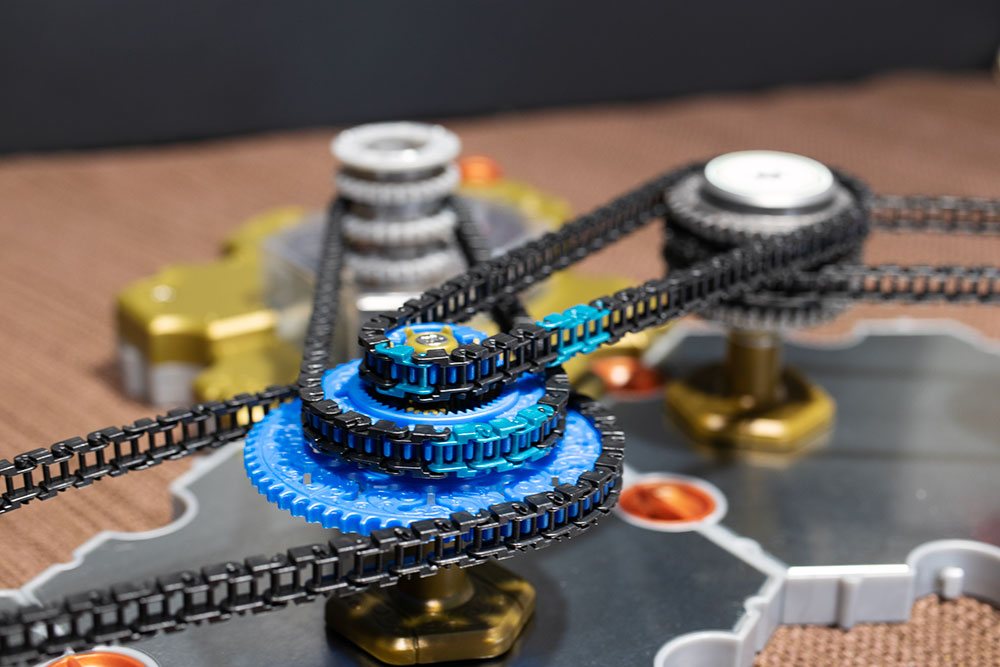 When we talk about tabletop games, one factor that can come up is “table presence.” There are just certain games that, when you walk by the table, you can’t help yourself from stopping and taking a longer look. Foundations of Rome, Cthulhu Wars, Return to the Dark Tower, Heroscape, Startropolis (totally biased here), and Fireball Island all come to mind.
When we talk about tabletop games, one factor that can come up is “table presence.” There are just certain games that, when you walk by the table, you can’t help yourself from stopping and taking a longer look. Foundations of Rome, Cthulhu Wars, Return to the Dark Tower, Heroscape, Startropolis (totally biased here), and Fireball Island all come to mind.
When I first saw Spintronics, I couldn’t help but be interested in giving it a deeper look. It’s a game featuring spinning gears connected with a series of chains. What’s not to love? Sounds like something you might want to check out? Read on to find out more.
Gameplay Overview:
Spintronics is an educational activity where you learn how electronics work over a series of puzzles with increasing difficulty. The game features a spiral-bound book that doubles as both a thematic comic book and also a teaching tool. There are 67 puzzles that accompany the story, and the game walks you through the concepts of each component.

The game starts you out with just a couple of gizmos: the spring-powered “battery”, a couple of resistor gears, and some links of chain. It will then explain basic concepts to you (this is how electricity works, this is what a resistor does), etc… And then it will present a series of puzzles. Each puzzle will have an initial setup, and then give you a goal (and usually a list of pieces you can use to accomplish the goal). As you progress through the book, it will step you through a series of puzzles in each chapter, with new pieces being added as you go.
Throughout all of Act 1 (the box we were sent), players will interact with the battery, a capacitor, an ammeter, and a couple of junctions, resistors, and switches. Once players finished all the puzzles in the box, they should have a basic understanding of concepts including series/parallel, capacitor circuits, logic circuits, and others. There is also an Act 2 box that players can buy to get into more advanced concepts.

Game Experience:
Sometimes in board gaming chats (shout out to our Discord channel), we debate whether a game is actually “a game or an activity”. Titles such as The Game or The Mind have been endlessly discussed in this forum. But Spintronics is definitely something I’d consider an activity/learning tool vs a game. This isn’t a strike against it in any way, but for those looking for rules, winners, losers, or tactics/strategies, that’s not what this is about.

However, as a learning tool, or simply a fun activity, it’s great. As an artist by trade, I have very little knowledge of mechanical circuits or electronics (despite my father being very experienced in these matters. You want a 70s-era console TV fixed, he’s your man). However, the puzzles are laid out in a way that makes even newbies like me able to understand and learn the concepts. They have a great “ramp up” to them where they start with simple concepts and build upon them. I think this would be great to give to a young kid interested in STEM, probably at least 7-8 years old. My kids are almost 5, and while they were interested in playing with the gears and bits, there were a bit too young to understand the concept presented (I did try though).

From a production standpoint, the component quality is amazing. The gears are all attached to the plate magnetically, making it easy to reposition things as needed. The only frustrating thing at the start was having to assemble the chains. When you open the box, 300 individual links are bagged up. So before you can even do the first puzzle, you need to create some chains. While they snap together easily (and come apart just as quickly when needed), it’s a bit tedious and time-consuming to be creating and taking apart links of chains. It’s a good system when assembled, but I almost wish they would have given us a few premade links of chains to get started with. However, once connected, things worked really well. Occasionally something would screw up when a chain would slip off a gear, but for the most part, it was an enjoyable experience with excellently manufactured parts.
The puzzles themselves are presented in a logical fashion, with varying degrees of difficulty. Sometimes, after introducing a new concept, the puzzle would be a bit too simple, and I could easily see in my head how it was done. But past those, there were many that took me a bit of experimenting and trial and error to figure out. Oddly, only a handful of answers to the puzzles are presented in the back of the book, with instructions to go to their website for all the solutions. I thought that was a bit odd, as a few sheets an extra paper couldn’t have affected the cost of the game that much. That being said, if you do go to the website, they do offer hints first, before showing you the actual solution (as an aminated gif).

Final Thoughts:
While I usually end reviews with a score, I’m not going to do that for Spintronics because it’s not so much of a game, but an educational experience—even if they are pretty fun to play around with. But if you ever wanted to learn about circuits or electricity, this is a fantastic way to do it. I think it could be a great experience to share with your kids (assuming they are old enough) as the puzzles are both informative and fun to figure out. Playing with the gears and gizmos is a lot of fun, and it’s really satisfying when it all comes together, I’ll probably be holding on to this one for when my kids are a bit older so I can share the experience with them.
If you or your kids have even a passing interest in electronics or puzzles, this one is definitely worth checking out.
Source: Board Game Quest





